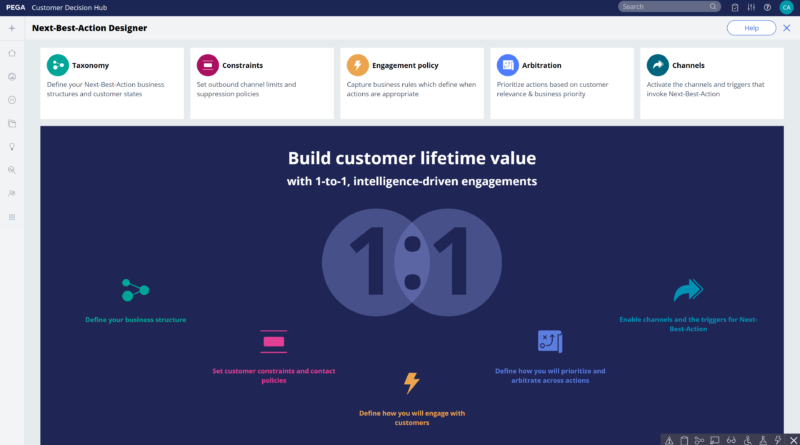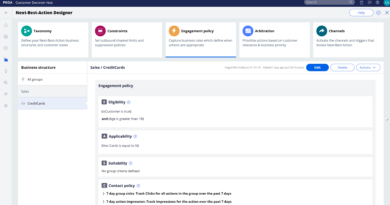Next-Best-Action Designer
Transcript
- Next-Best-Action Designer guides you through the creation of a Next-Best-Action strategy for your business.
- The Next-Best-Action Designer user interface allows you to easily define, manage and monitor Next-Best-Actions.
- The 5 components represent the steps that need to be completed to define Next-Best-Actions.

Taxonomy – To define the business structure for your organization
- Use the Taxonomy component to define the hierarchy of Business Issues and Groups to which an action belongs.
- Business Groups are used to organize customer actions into categories.
For example, as part of the business Issue of Acquisition, you can create Groups for products like Credit Cards, Mortgages, or Personal Loans, with the intention of offering these to potential customers.

Constraints – To implement channel limits and constraints
- Use Constraints to specify outbound contact limits as well as to limit overexposure to a specific action or group of actions

Customer contact limits :
- It allow you to limit the number of interactions that a customer can receive over a given period of time on a specific channel
For example, you can decide that you do not want your customers to receive more than one email per week or one SMS messages per week.

Contact Policy library :
- Contact Policy rules are reusable across all Business Issues and Groups.
- You can define more extensive suppression rules by creating Contact Policy rules in the library
For example, an action can be suppressed for a customer for seven days after the customer has seen an ad for that action five times.
Suppressing or pausing an action prevents over-exposure by limiting the number of times a customer is exposed to the same action.

Engagement policy – To define the rules that control which actions are offered to which customers.
- Use Engagement policies to define when specific actions or groups of actions are appropriate for customers.

Eligibility:
- It determines whether or not a customer qualifies for an action or group of actions.
For example, an action may only be available for customers and over a specific age

Applicability:
- It determines if an action or group of actions is relevant for a customer at a particular point in time
For example, a discount on a specific credit card may not be relevant for a customer who already owns a card.

Suitability:
- It determines if an action or group of actions is appropriate for a customer for ethical or empathetic reasons.
For example, a new loan offer may not be appropriate for a customer whose credit score is low, even though it might be profitable for the bank.

Contact Policy:
- It determine when an action or group of actions should be suppressed and for how long.
For example, you can suppress an action after a specific number of promotional messages has been sent to customers.

Arbitration – To configure how actions are prioritized.
- Use Arbitration to determines how the Customer Decision Hub prioritizes the list of eligible and appropriate actions that come out of each group.
The factors weighed in arbitration are: Propensity, Context weighting, Action value, and Business levers, each represented by numerical values.

Propensity:
- It is the likelihood of a customer responding positively to an action. This is calculated by Artificial Intelligence (AI).

Context weighting:
- It allows you to assign weighting to a specific context value for all actions within an Issue or Group.
For example, if a customer contacts the bank to change their address, the weight of the Service context will increase, and the highest priority action will be to ensure that the relevant service is delivered to the customer.

Action value:
- It enables you to assign a financial value to an action and prioritize high-value actions over low-value ones.
For example, promoting an unlimited data plan might be more profitable for the company than a limited data plan. Action values are typically normalized across Issues and Groups.

Business levers:
- It enable you to accommodate ad hoc business priorities by specifying a weight for an action or Group of actions and/or its associated Business Issue.

Channels – To configure when and where Next-best-Action is triggered.
- Use Channels to enable Next-best-Actions to be delivered via inbound, outbound and paid channels.

- These channels can be toggled on or off. If a channel is toggled off, the Next-Best-Actions will not be delivered to that channel.

Triggers:
- A trigger is a mechanism whereby an external channel invokes the execution of a Next-Best-Action decisioning process for specific Issues and Groups. The result will be delivered back to the invoking channel.





